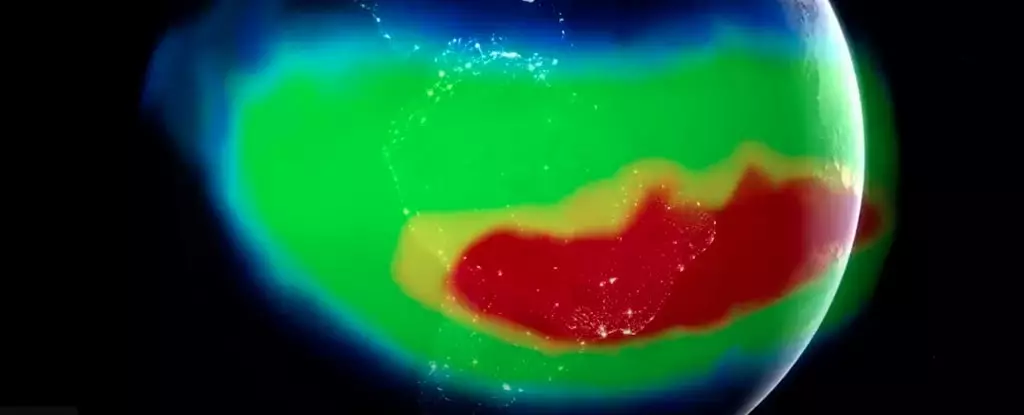For years, scientists have been captivated by the peculiar anomaly in Earth’s magnetic field known as the South Atlantic Anomaly (SAA). This extensive zone, characterized by reduced magnetic intensity, is positioned above the surface of the planet, primarily spanning the regions between South America and southwestern Africa. While its influence on day-to-day life remains minimal, a thorough examination reveals that the SAA raises significant concerns, particularly for NASA’s spacecraft navigating through low-Earth orbit.
Earth’s magnetic field is the planet’s protective shield against solar radiation and charged particles. This anomaly, metaphorically described as a “dent” or “pothole in space,” presents a unique challenge to scientific exploration and satellite operations. As these spacecraft traverse the anomaly, they become vulnerable to heightened levels of charged solar particles, which can disrupt their electronic systems. This vulnerability necessitates that satellite operators proactively suspend sensitive operations when entering this magnetic region, demonstrating the SAA’s tangible impact on our technological advancements.
The Science Behind the Anomaly
Understanding the SAA requires delving into the complex interplay of geological and geophysical processes that govern Earth’s magnetic field. At the heart of this phenomenon lies the molten iron swirling within Earth’s outer core, generating a magnetic field that is anything but uniform. NASA geophysicist Terry Sabaka has pointed out that the field results from various sources, complicating the magnetic landscape.
A significant factor contributing to the anomaly’s existence is the African Large Low Shear Velocity Province, a dense rock mass situated approximately 2,900 kilometers below the Earth’s surface. This geological oddity appears to disrupt the magnetic field’s generation, yielding the low-intensity region that defines the SAA. The tilt of the planet’s magnetic axis further exacerbates the weakening in this area, hinting at profound geological activity at play beneath our feet.
Interestingly, this anomaly has been demonstrated to evolve over time, with research revealing that it drifts and may even be in the process of splitting into two distinct centers of magnetic intensity. Such revelations not only fuel curiosity about the SAA but also underscore the necessity for comprehensive and continuous observation by researchers.
The Risks to Spacecraft and Technology
The SAA poses particular challenges to spacecraft, especially the International Space Station and numerous satellites that orbit Earth at low altitudes. Within the anomaly, the diminished magnetic shielding allows high-energy protons from solar activity to penetrate deeper, resulting in potential malfunctions or permanent damage to onboard systems. These incidents can manifest as glitches in data transmission, loss of crucial measurements, or failures of vital components.
Satellite operators are persistently tasked with managing these risks. Regular protocols dictate the shutdown of specific systems before entering the SAA zone, illustrating the ongoing challenges of operating satellites in such a dynamic environment. Despite the relatively rare occurrence of significant damage, the implications of data loss or operational failures require careful consideration as humanity increasingly relies on satellite communication and imaging technologies.
Unfolding Insights and Ongoing Research
The complexity of the South Atlantic Anomaly reveals itself in the continuous flow of new research. Studies suggest that the anomaly’s behavior may not be entirely novel; it seems to have occurred repeatedly throughout Earth’s history. Analysis indicates that the SAA could have been a recurring phenomenon for the last 11 million years, raising intriguing questions about its role in Earth’s magnetic evolution and whether it foreshadows larger geomagnetic shifts.
NASA’s commitment to understanding the SAA is critical, not just for immediate operational safety but also for the broader scientific implications surrounding geomagnetic fields. Heliophysicist Ashley Greeley’s findings highlighted the anomaly’s consistent drift, emphasizing the necessity for ongoing research efforts. As scientists continue to analyze its shifting morphology, the SAA serves as a powerful reminder of the dynamic nature of our planet’s magnetic field.
As researchers delve deeper into the intricacies of the SAA, the anomaly emerges not merely as a challenge but as a gateway for discovering more about Earth’s underlying systems. The endeavor to unravel the SAA encapsulates the human spirit of exploration and innovation, urging us to look beyond the immediate challenges and seek understanding in the most unusual places. The future of how we interact with space and manage our technology could rest on the insights gleaned from this enigmatic magnetic region.


Leave a Reply